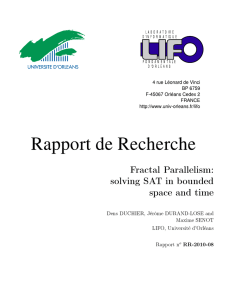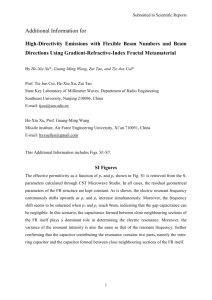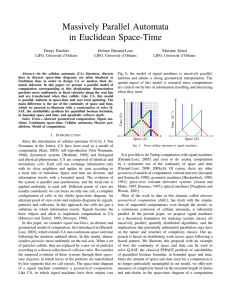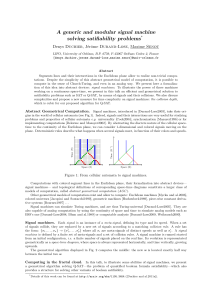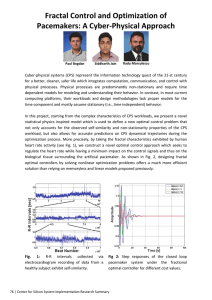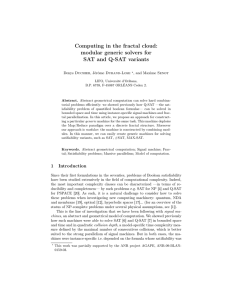Fractal Parallelism: Solving SAT in bounded space and time
advertisement
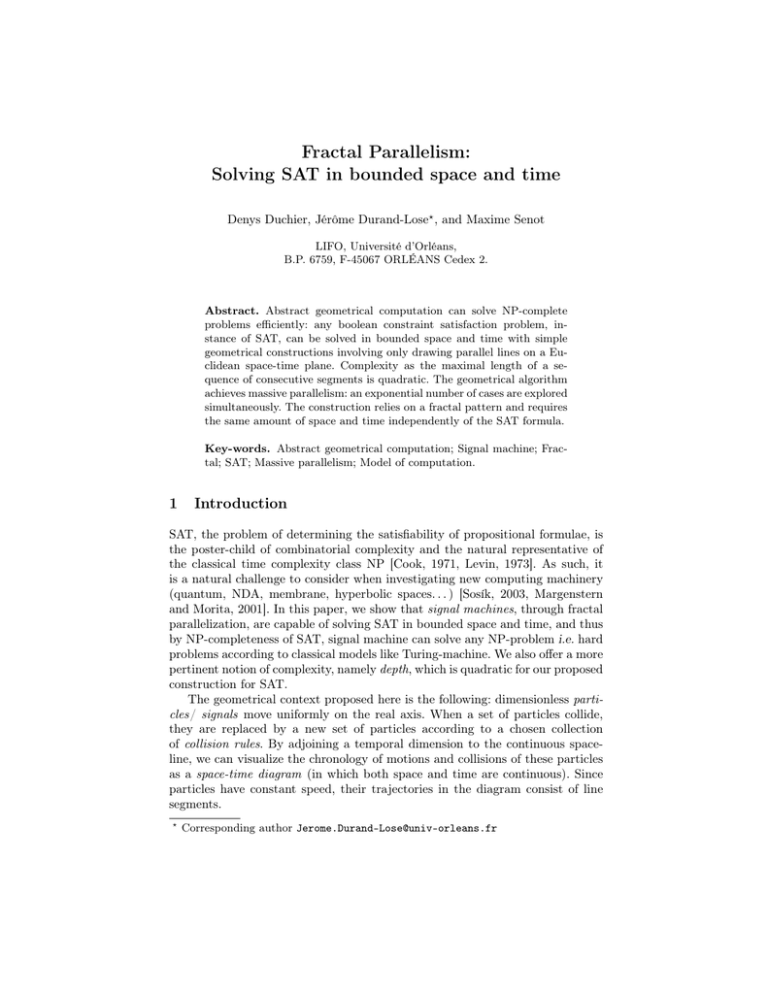
Fractal Parallelism:
Solving SAT in bounded space and time
Denys Duchier, Jérôme Durand-Lose? , and Maxime Senot
LIFO, Université d’Orléans,
B.P. 6759, F-45067 ORLÉANS Cedex 2.
Abstract. Abstract geometrical computation can solve NP-complete
problems efficiently: any boolean constraint satisfaction problem, instance of SAT, can be solved in bounded space and time with simple
geometrical constructions involving only drawing parallel lines on a Euclidean space-time plane. Complexity as the maximal length of a sequence of consecutive segments is quadratic. The geometrical algorithm
achieves massive parallelism: an exponential number of cases are explored
simultaneously. The construction relies on a fractal pattern and requires
the same amount of space and time independently of the SAT formula.
Key-words. Abstract geometrical computation; Signal machine; Fractal; SAT; Massive parallelism; Model of computation.
1
Introduction
SAT, the problem of determining the satisfiability of propositional formulae, is
the poster-child of combinatorial complexity and the natural representative of
the classical time complexity class NP [Cook, 1971, Levin, 1973]. As such, it
is a natural challenge to consider when investigating new computing machinery
(quantum, NDA, membrane, hyperbolic spaces. . . ) [Sosík, 2003, Margenstern
and Morita, 2001]. In this paper, we show that signal machines, through fractal
parallelization, are capable of solving SAT in bounded space and time, and thus
by NP-completeness of SAT, signal machine can solve any NP-problem i.e. hard
problems according to classical models like Turing-machine. We also offer a more
pertinent notion of complexity, namely depth, which is quadratic for our proposed
construction for SAT.
The geometrical context proposed here is the following: dimensionless particles/ signals move uniformly on the real axis. When a set of particles collide,
they are replaced by a new set of particles according to a chosen collection
of collision rules. By adjoining a temporal dimension to the continuous spaceline, we can visualize the chronology of motions and collisions of these particles
as a space-time diagram (in which both space and time are continuous). Since
particles have constant speed, their trajectories in the diagram consist of line
segments.
?
Corresponding author Jerome.Durand-Lose@univ-orleans.fr
Time (N)
Time (R + )
Models of computation, conventional or not, are frequently based on mathematical idealizations of physical concepts and investigate the consequences, on
computational power, of such abstractions (quantum, membrane, closed timelike curves, black holes. . . ) [Păun, 2001, Brun, 2003, Etesi and Németi, 2002].
However, oftentimes, the idealization is such that it must be interpreted either
as allowing information to have infinite density (e.g. an oracle), or to be transmitted at infinite speed (global clock, no spatial extension. . . ). On this issue, the
model of signal machines stands in contradistinction with other abstract models
of computation: it respects the principle of causality, density and speed of information are finite, as are the sets of objects manipulated. Nonetheless, it remains
a resolutely abstract model with no apriori ambition to be physically realizable,
and it deals with theoretical issues such as computational power.
Signal machines are Turing-universal [Durand-Lose, 2005] and allows to do
analog computation by a systematic use of the continuity of space and time
[Durand-Lose, 2008, 2009a,b]. Other geometrical models of computation exist
and allow to compute: colored universe [Jacopini and Sontacchi, 1990], geometric
machines [Huckenbeck, 1989], piece-wise constant derivative systems [Asarin and
Maler, 1995, Bournez, 1997], optical machines [Naughton and Woods, 2001]. . .
Most of the work to date in this domain, called abstract geometrical computation (AGC), has dealt with the simulation of sequential computations even
though the model, seen as a continuous extension of cellular automata, is inherently parallel. (The connexion with CA is briefly illustrated on Fig. 1) In the
present paper, we describe a massively parallel evaluation of all possible valuations for a given propositional formula. This is the first time that parallelism
is really used in AGC and that an algorithm is proposed to solve directly hard
problems (without simulating another model).
Space (Z)
Space (R)
Fig. 1. From cellular automata to signal machines.
To achieve this, we follow a fractal pattern to a depth of n (for n propositional
variables) in order to partition the space in 2n regions corresponding to the 2n
possible valuations of the formula. We call the resulting geometrical construction
the combinatorial comb of propositional assignments. With a signal machine,
such an exponential construction fits in bounded space and time regardless of
the number of variables.
This constant time has to be understood in the context of continuous space
and time. Feynman famously remarked that “there’s plenty of room at the bottom.” This is especially the case here where, by scaling things down, room can be
provided anywhere. With proper handling, this also leads to unbounded acceleration [Durand-Lose, 2009a]. The fractal pattern provides a way to automatically
scale down. The one implemented here is a recursive subdivision in halves.
Once the combinatorial comb is in place, it is used to implement a binary
decision tree for evaluating the formula, where all branches are explored in parallel. Finally, all the results are collected and disjunctively aggregated to yield
the final answer.
Signal machines are presented in Section 2. Sections 3 to 7 detail step by step
our algorithm to solve SAT by geometrical computation: splitting the space,
coding and generating the formula, broadcasting it, evaluating it and finalizing
the answer by collecting the evaluations. Complexities are discussed in Section 8
and conclusion and remarks are gathered in Section 9.
2
Definitions
Signal machines are an extension of cellular automata from discrete time and
space to continuous time and space. Dimensionless signals/particles move along
the real line and rules describe what happens when they collide.
Signals. Each signal is an instance of a meta-signal. The associated meta-signal
defines its velocity and what happen when signals meet. Figure 2 presents a very
simple space-time diagram. Time is increasing upwards and the meta-signals are
indicated as labels on the signals. Existing meta-signals are listed on the left of
Fig. 2.
Collision rules
−
→
−
→ −
→
{ w, div } → { w, hi , lo }
← −w
ba−
−
→
←−−
ck
{ lo , w } → { back, w }
−
→
−
→
←
−
−
lo
{ hi , back } → { w }
w
w
→
−
hi
Meta-Signals Speed
w
0
−
→
div
3
−
→
hi
1
−
→
3
lo
←−−
back -3
→v
−
di
w
w
Fig. 2. Geometrical algorithm for computing the middle
Generally, we use over-line arrows to indicate the direction of propagation of
−
−
a meta-signal. For example, ←
a and →
a denotes two different meta-signals; but as
can be expected, they have similar uses and behaviors. Similarly br and bl are
different; both are stationary, but one is meant to be the version for right and
the other for left.
Collision rules. When a set of signals collide, they are replaced by a new set of
signals according to a matching collision rule. A rule has the form:
{σ1 , . . . , σn } → {σ10 , . . . , σp0 }
where all σi are meta-signals of distinct speeds as well as σj0 (two signals cannot
collide if they have the same speed and outcoming signals must have different
speeds). A rule matches a set of colliding signals if its left-hand side is equal to
the set of their meta-signals. By default, if there is no exactly matching rule for
a collision, the behavior is defined to regenerate exactly the same meta-signals.
In such a case, the collision is called blank. Collision rules can be deduced from
space-time diagram as on Fig. 2. They are also listed on the right of this figure.
Signal machine. A signal machine is defined by a set of meta-signals, a set of
collision rules, and and initial configuration, i.e. a set of particles placed on the
real line. The evolution of a signal machine can be represented geometrically as a
space-time diagram: space is always represented horizontally, and time vertically,
growing upwards. The geometrical algorithm displayed in Fig. 2 computes the
middle: the new w is located exactly half way between the initial two w.
3
Combinatorial comb
In order to determine by brute force whether a propositional formula with n
variables is satisfiable, 2n cases must be considered. These cases can be recursively enumerated using a binary decision tree. In this section, we explain how
to construct in parallel the full decision tree in constant space and time. This
is done for a fixed formula, so that n is a constant, and the construction of the
signal machine depends on it. In later sections we will use this tree to evaluate
the formula.
The intuition is that the decision for variable xi will be represented by a
stationary signal: the space on the left should be interpreted as xi = false,
and the space on the right as xi = true. Then we will similarly subdivide the
spaces to the left and to the right, with stationary signals for xi+1 , and so on
recursively for all variables as illustrated in Fig. 3(a).
−−→
Starting with two bounding signals w and an initiator start, space is recursively divided as shown in Fig. 3(b). The first step works exactly as in Fig. 2, but
then continues on to a depth of n: the counting is realized by using successively
−
→, −
→ −
→
m
0 m1 , m2 . . . The necessary rules and meta-signals are summarized in Tab. 1
Since each level of the tree is half the height of the previous one, the full tree
can be constructed in bounded time regardless of its size. Also, note that the
bottom level of the tree is not xn but br and bl . These are used both to evaluate
the formula and to aggregate the results as explained later.
4
Formula encoding
In this section, we will explain how to represent the formula as a set of signals.
This is illustrated with the following example:
φ = (x1 ∨ ¬x2 ) ∧ x3
w bl x3 br x2 bl x3 br x1 bl x3 br x2 bl x3 br w
x3 x2 x3 x1 x3 x2 x3
x3 x3 x3 x3 x3 x3 x3 x3
w
x3
x3
x3
x3
x2
x2
x2
x2
x2
x2
x1
x1
w
←
− x2 m
−
→
m
←
−
−
2→
a 2
a
→
−
a
←
m−1
←
−
a
x1
←
− x2 m
−
→
m
←
−
−
2→
a 2
a
←
−
a
−
→
m
1
→
−
a
w
←
−
a
w
w
−
→
m
0
x1
(a) Cases identification
w
−−−→
startlo
w
(b) Division process
Fig. 3. Combinatorial comb.
Meta-Signal Speed
−−→ −−−→ −
start, startlo , →
a
3
−
→
−
→
−
→
1
m0 , m1 , m2 . . .
x1 , x2 , x3 . . .
0
←
-1
m−0 , ←
m−1 , ←
m−2 . . .
←
−
-3
a
bl , br
0
Collision rules
−−→
−−−→ →
{ start, w } → { w, startlo , −
m0 }
−−−→
←
−
{ startlo , w } → { a , w }
−
→
{ w, ←
a } → { w, −
a }
−
→
←
−
{ a,w}→{ a,w}
→, ←
−
←
− ←−−−
−−−→
{−
m
i a } → { a , mi+1 , xi , mi+1 ,
→
−
−−
−−−→
{−
a,←
m−i } → { ←
a,←
m−
i+1 , xi , mi+1 ,
−
→
←
−
{ mn , a } → { br }
→
{−
a,←
m−
n } → { bl }
Table 1. Meta-Signals and collision rules to build the comb.
−
→
a }
−
→
a }
A formula can be viewed as a tree whose nodes are labeled by symbols (connectives and variables). The evaluation of the formula for a given assignment is
a bottom-up process that percolates from the leaves toward the root. In order
to model that process, we shall represent each node of the tree by a signal. In
Fig. 4(a), each node is additionally decorated with a path from the root uniquely
identifying its position in the tree: thus we are able to conveniently distinguish
multiple occurrences of the same symbol. These decorated symbols provide convenient names for the required meta-signals (see Fig. 4(b)). Thus a formula of
size l requires the definition of 2l meta-signals.
The signals for all subformulae are sent along parallel trajectories and form
a beam. They are stacked in the diagram in order of nesting, inner-most subformulae first. This order is important for the process of percolation that will take
place at the end.
The process can be initiated by just 3 signals as shown in Fig. 4(c). The delay
→ and φ , controls the width of the beam.
between the two signals from the left, −
m
0
R
Since space is continuous, this width can be made as small as desired.
∧
xr3
∨l
xll
1
φ −−−−→
φW W collect
−−→
store
→
−
∧
→
−r
x3
¬lr
→
−l
∨
−
→
¬lr
−
→
xlrc
2
→
−ll
x1
xlrc
2
(a) Labeled tree
←
−
∧,
−
→
∧,
←
−
∨l ,
−
→l
∨,
Meta-Signal Speed
←
− ←
− ←− ←
−
r
¬lr , xll1 , xlrc
-1
2 , x3
−
→
−
→
−
→
−
→
r
¬lr , xll1 , xlrc
1
2 , x3
(b) Generated signals
−
→
m
0
φ−
R→
m
0
φL
(c) Initial
displaying
Fig. 4. Compiling the formula
5
Propagating the beam
The formula’s beam is now propagated down the decision tree. For each decision
point, the beam is duplicated: one part goes through, the other is reflected. Thus,
by construction, every branch of the beam tree encounters a decision point for
every variable at least once. If the beam is sufficiently narrow, the guarantee
becomes “exactly once,” as shown in Fig. 5(a). Although we lack space for a
detailed explanation, it can easily be verified that emitting φL from the origin
with a speed of 1 − 7/(3k · 2n+2 ) is more than sufficient, where k is the number
of signals in the beam and n is the number of variables in the formula. This
rational number can be computed in time at most quadratic in the size of the
formula.
When the beam encounters a decision point (a stationary signal for a variable xi ), then a split occurs producing two branches. Except for the sign of their
velocity, most signals remain identical in both branches; most, except those corresponding to occurrences of xi : those become false in the left branch and true
in the right branch. Fig. 5(b) shows the beam intersecting the decision signal for
→
−
←
−
→
−
variable x1 . Note how the incident signal xll1 becomes fll on the left and tll on
the right; the path decoration is preserved since, as we shall see, it is essential
later for the percolation process. This is achieved by the collision rule:
→
−
←
−
→
−
{ xll1 , x1 } → { fll , x1 , tll }
←−−−−
−−−−→
x1 collect
←−collect
−
−store
←
−r ←
−−→
∧
store
←
−
x
←
−lr ∨l 3
¬
→
−
←
−
∧
xlrc
2
→
−r
←
−
x
3
fll
→
−l
←
m−1
∨
−
→
¬lr
−
→
xlrc
2
→
−ll
t
←
−
a
−
→
m
1
−−−−→
collect
−−→
→
−
store→
a
− −
− →
→ →
−
→ −
∧ xr3 →
−ll
∨l ¬lr xlrc
←
−
−
→
x1 m
2
a
0
(a) Corridors
(b) Split
Fig. 5. Propagating the formula’s beam
Since a decision point is encountered exactly once for each variable on each
branch of the beam tree, at the bottom of the tree, all signals corresponding to
occurrences of variables have been assigned a boolean value.
6
Evaluating the formula
Remember how, at the very bottom of the decision tree, we added an extra division using signals bl or br : their purpose is to initiate the percolation process.
bl is for starting the percolation process of a left branch, while br is for a right
branch. Fig. 6 zooms on one case of our example: The invariant is that all sig→
−
nals that reach br have determined boolean values. When tll reaches br , it gets
←
−
reflected as Tll . The change from lowercase to uppercase indicates that the subformula’s signal is now able to interact with the signal of its parent connective.
The stacking order ensures that reflected signals of subformulae will interact
with the incoming signal of their parent connective before the latter reaches br .
This enforces the invariant.
A connective is evaluated by colliding with the (uppercased) boolean signals
of its arguments. For example, the disjunction collides with its first argument.
Depending on its value, it becomes the one-argument function identity or the
constant true. This is the way the rules of Tab. 2 should be understood.
Note how the path decorations are essential to ensure that the right subformulae interact with the right occurrences of connectives. Conjunctions and
−−→
negations can be handled similarly. Finally, store projects the truth value of
−−−−→
the formula’s root on br where it is temporarilly stored until collect starts the
aggregation of the results.
←−−−−
success
T
−
→
T∅
−−−−→
←
−br
collect
T
→
−
t
→
− ←
−br
id Tr
−−→
←
− →
store
−
Tl tr
←
−br
Tl
→
−l
→
−
∧
t
←
−lrbr
−
→
F
→
−r
t()l →
−lr
t
f
←
− −
→ ←−br
Tll ¬lr Tlrc
←
− −
→
→
−l
Tll tlrc
←
−br
∨
Tll
−
→lr
¬ −
→
br
−ll
tlrc →
t
−
→
m
3
←
−
a
Fig. 6. Evaluation at the bottom of the comb.
−
→ ←
−
−→
−→ ←
−
−
→
−
→ ←
−
−
→
{ ∨l , Tll } → { t()l }
{ t()l , Tlr } → { tl }
{ idl , Tlr } → { tl }
−
→ ←
−
−
→
−→ ←
−
−
→
−
→ ←
−
−
→
{ ∨l , Fll } → { idl }
{ t()l , Flr } → { tl }
{ idl , Flr } → { fl }
Table 2. Collision rules to evaluate the disjunction ∨l .
7
Collecting the results
At the end of the propagation phase, the results of evaluating the formula for all
possible assignments have been stored as stationary signals replacing the bl and
br signals. We must now compute the disjunction of all these results. This is the
←−−−−
−−−−→
collection phase and it is initiated and carried out by signals collect and collect
as illustrated in Fig. 7. The required collision rules are summarized in Tab. 3.
{ B,
{ B,
−
→
{ B1 ,
−
→
{ B1 ,
−
−−−
→
collect
←
−−−
−
collect
←
−
R, B2
←
−
L, B2
}
}
}
}
→
→
→
→
{
{
{
{
←
−
B }
−
→
B }
−
→
B3 }
←
−
B3 }
−
−−−
→
←
−−−
−
−
−−−
→
{ collect, xi } → { collect, L, collect }
←
−−−
−
←
−−−
−
−
−−−
→
{ xi , collect } → { collect, R, collect }
for B, B1 , B2 , B3 ∈ {T, F}
and B3 = B1 ∨ B2
Table 3. Collection rules
Fig. 7. Collecting the result.
Putting it all together, we get the space-time diagram of Fig. 8. Although,
it cannot be seen on the picture, four signals are emitted on the first collision
(bottom left). Two have very close speeds so that when the signals for the formula
are generated, the resulting beam is sufficiently narrow (see Fig. 4(c) for a zoom
in on this part).
8
Complexities
We now turn to a crucial question: what is the complexity of our construction
as a function of the size of the formula? What is a meaningful way to measure
this complexity?
The width of the construction measures the space requirement: it is independent of the formula and can be fixed to any value we like. The height measures
the time requirement: it is also independent of the formula because of the fractal
construction and the continuity of space-time. If more variables are involved, the
comb gains extra levels, but its height remains bounded by the fractal.
As a consequence, while width (space) and height (time) are the natural
continuous extensions of traditional complexity measures used in the discrete
universe of cellular automata, in the context of abstract geometrical computations, they loose all pertinence.
Instead we should regard our construction as a computational device transforming inputs into outputs. The inputs are given by the initial state of the
signal machine at the bottom of the diagram. The output is the computed result
that comes out at the top. The transformation is performed in parallel by many
threads: a thread here is an ascending path through the diagram from an input
to the output. The operations that are “performed” by the thread are all the
collisions found along the path.
Thus, if we view the diagram as an acyclic graph of collisions (vertices) and
signals (arcs), the time complexity can then be defined as the maximal length
Fig. 8. The whole diagram.
of a chain and the space complexity can be defined as the maximal length of an
anti-chain.
Let t be the size of the formula and n the number of variables. At the bottom
level of the comb, there is an anti-chain of length approximately t2n . The space
complexity is exponential.
Generation of the comb, initiation, propagation, evaluation and aggregation
contribute along any path a number of collisions at most linear in the size of the
formula. However, intersections of incident and reflected branches at every level
add O(nt) because there are O(n) levels and the beam consists of O(t) parallel
signals. Thus the time complexity is O(nt).
It should also be pointed out that the signal machine depends on the formula
but the compilation of the formula into a rational signal machine is done in
polynomial time, presicely in quadratic time. The size of the generated signal
machine is as follows. The number of meta-signals is linear in n for the comb
and in t for the formula. The number of non blank collision rules is proportional
to nt (each node of the formula is split on each variable). Counting the blank
collision rules, it sums up to t2 . There are only seven distinct speeds: −6, −3,
−1, 0, 1, 3 and one special rational value for the initiation.
9
Conclusion
In this article, we have shown how to achieve massive parallelism with signal
machines, by means of a fractal pattern. We call this fractal parallelism and it
is a novel contribution in the field of abstract geometrical computation.
Our approach is able to solve SAT, and thus any NP-problem, in bounded
space and time by a methodic use of continuity. It does so while respecting
the principle that everywhere the density of information is finite and its speed
is bounded; a principle typically not considered by other abstract models of
computation.
The complexity is not hidden inside the compilation of the machine nor in the
initial configuration. Admittedly, the “magic” rational velocity used to control
the narrowness of the beam constitutes an infelicity of presentation as it is the
only one that depends on the formula. It can be eliminated using a slightly more
involved beam-narrowing technique, but that extension is beyond the scope of
the present article.
Since, clearly, time and space are no longer appropriate measures of complexity, we have also proposed to replace them respectively by the maximum
length of a chain and an anti-chain in the space-time diagram regarded as a
directed acyclic graph. According to these new definitions, our construction has
exponential space complexity and quadratic time complexity. The compilation
of formulae into signal machines can be done uniformly in quadratic time by a
single classical machine.
We are currently furthering this research along two axes. First, we are considering how to tackle other complexity classes such as PSPACE, #P or EXPTIME using abstract geometrical computation. Second, we would like to design
a generic signal machine for SAT, i.e. a single machine solving any instance of
SAT, where the formula is merely compiled into an initial configuration.
Bibliography
Eugene Asarin and Oded Maler. Achilles and the Tortoise climbing up the
arithmetical hierarchy. In FSTTCS ’95, number 1026 in LNCS, pages 471–
483, 1995.
Olivier Bournez. Some bounds on the computational power of piecewise constant
derivative systems (extended abstract). In ICALP ’97, number 1256 in LNCS,
pages 143–153, 1997.
Todd A. Brun. Computers with closed timelike curves can solve hard problems
efficiently. Foundations of Physics Letters, 16:245–253, 2003.
Stephen A. Cook. The complexity of theorem proving procedures. In 3rd Symposium on Theory of Computing (STOC 71), pages 151–158. ACM, 1971.
Jérôme Durand-Lose. Abstract geometrical computation: Turing computing ability and undecidability. In B.S. Cooper, B. Löwe, and L. Torenvliet, editors,
New Computational Paradigms, 1st Conf. Computability in Europe (CiE ’05),
number 3526 in LNCS, pages 106–116. Springer, 2005.
Jérôme Durand-Lose. Abstract geometrical computation with accumulations:
Beyond the Blum, Shub and Smale model. In Arnold Beckmann, Costas
Dimitracopoulos, and Benedikt Löwe, editors, Logic and Theory of Algorithms,
4th Conf. Computability in Europe (CiE ’08) (abstracts and extended abstracts
of unpublished papers), pages 107–116. University of Athens, 2008.
Jérôme Durand-Lose. Abstract geometrical computation 3: Black holes for classical and analog computing. Nat. Comput., 8(3):455–572, 2009a.
Jérôme Durand-Lose. Abstract geometrical computation and computable analysis. In J.F. Costa and N. Dershowitz, editors, International Conference on
Unconventional Computation 2009 (UC ’09), number 5715 in LNCS, pages
158–167. Springer, 2009b.
Gábor Etesi and Istvá Németi. Non-turing computations via Malament-Hogarth
space-time. International Journal of Theoret. Physics, 41:341–370, 2002.
Ulrich Huckenbeck. Euclidian geometry in terms of automata theory. Theoret.
Comp. Sci., 68(1):71–87, 1989.
Giuseppe Jacopini and Giovanna Sontacchi. Reversible parallel computation: an
evolving space-model. Theoret. Comp. Sci., 73(1):1–46, 1990.
Leonid Levin. Universal search problems. In Problems of Information Transmission., pages 265–266, 1973.
Maurice Margenstern and Kenichi Morita. NP problems are tractable in the
space of cellular automata in the hyperbolic plane. Theor. Comp. Sci., 259
(1-2):99–128, 2001.
Thomas J. Naughton and Damien Woods. On the computational power of a
continuous-space optical model of computation. In M. Margenstern, editor,
Machines, Computations, and Universality (MCU ’01), number 2055 in LNCS,
pages 288–299, 2001.
Gheorghe Păun. P systems with active membranes: Attacking NP-Complete
problems. Journal of Automata, Languages and Combinatorics, 6(1):75–90,
2001.
Petr Sosík. Solving a PSPACE-Complete problem by P-systems with active
membranes. In M. Cavaliere, C. Martín-Vide, and G. Păun, editors, Brainstorming Week on Membrane Computing, pages 305–312. Tarragona: Universidad Rovira i Virgili, 2003.

